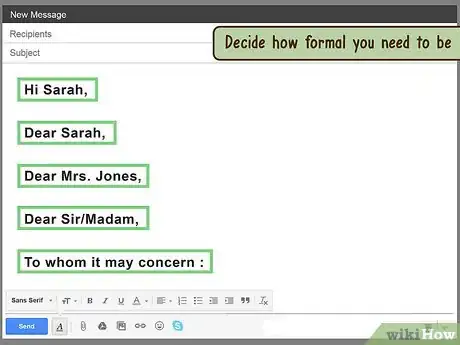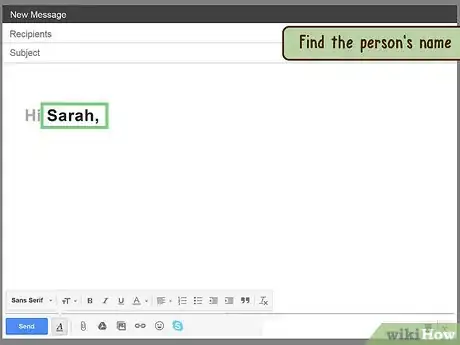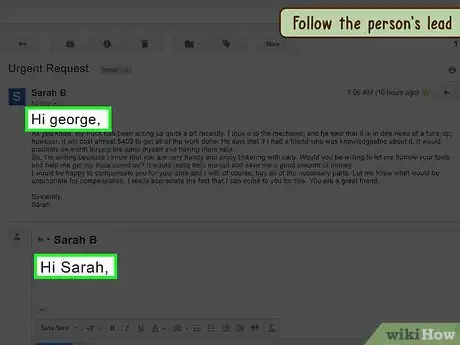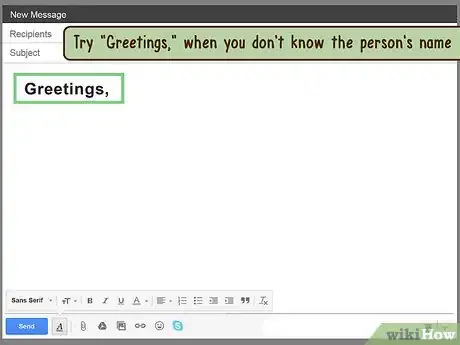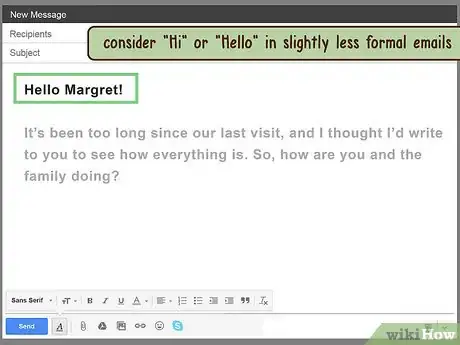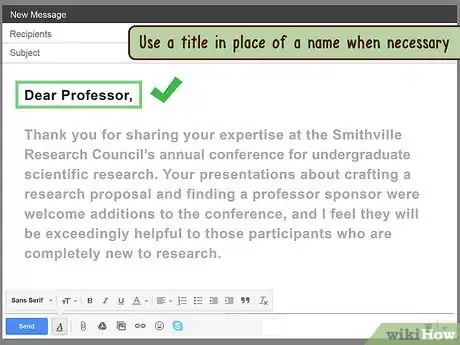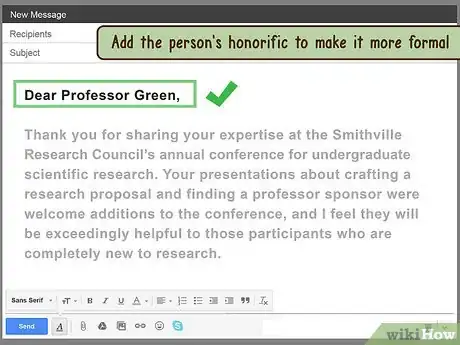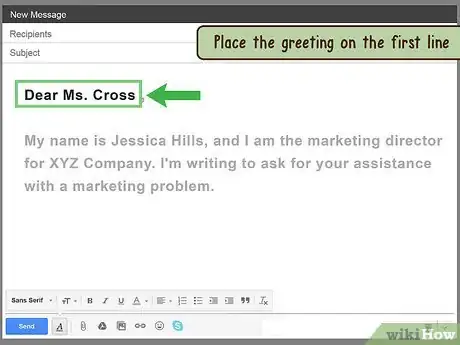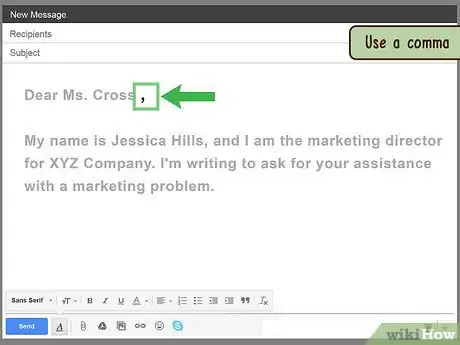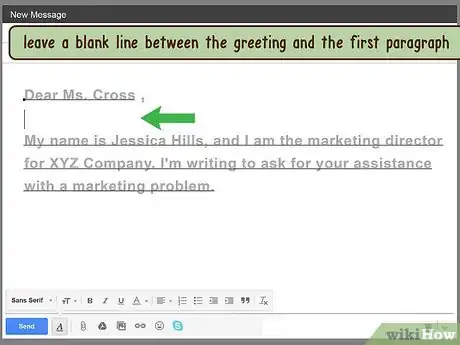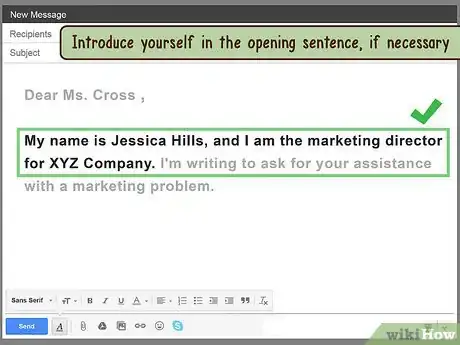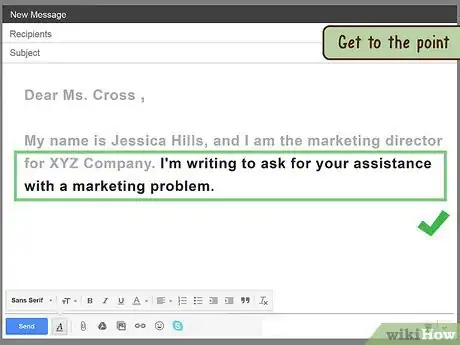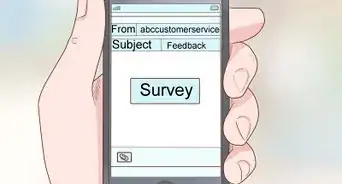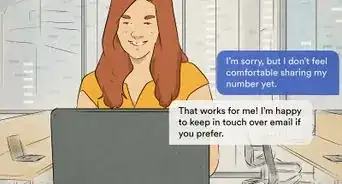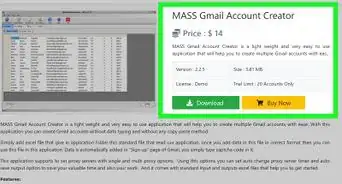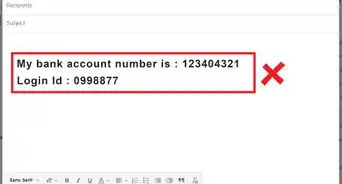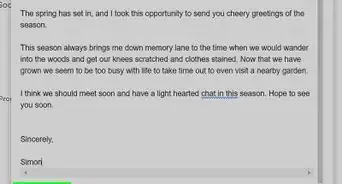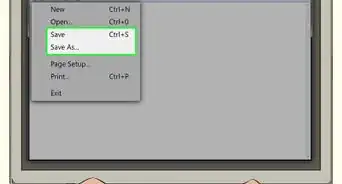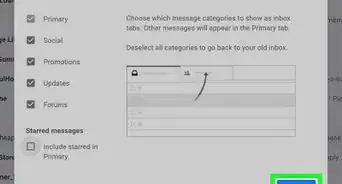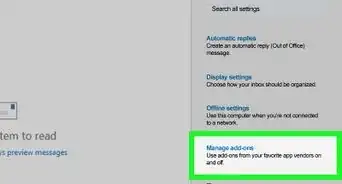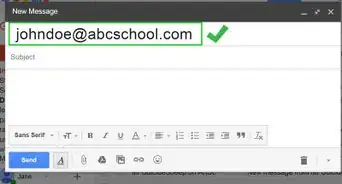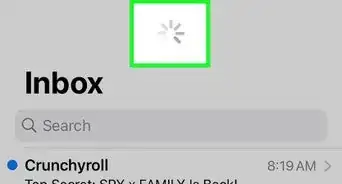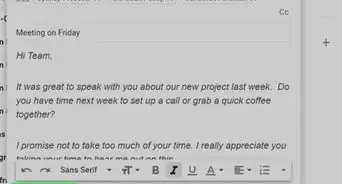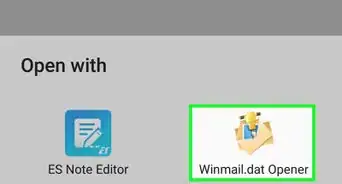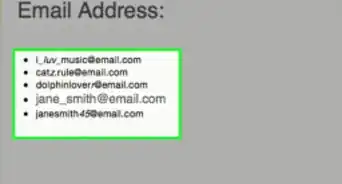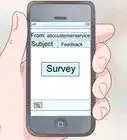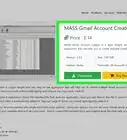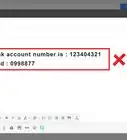This article was co-authored by Tami Claytor. Tami Claytor is an Etiquette Coach, Image Consultant, and the Owner of Always Appropriate Image and Etiquette Consulting in New York, New York. With over 20 years of experience, Tami specializes in teaching etiquette classes to individuals, students, companies, and community organizations. Tami has spent decades studying cultures through her extensive travels across five continents and has created cultural diversity workshops to promote social justice and cross-cultural awareness. She holds a BA in Economics with a concentration in International Relations from Clark University. Tami studied at the Ophelia DeVore School of Charm and the Fashion Institute of Technology, where she earned her Image Consultant Certification.
This article has been viewed 307,163 times.
By its nature, email is not as formal as letter-writing. However, you'll still have times when you need to be more formal in your email writing. Think about who the recipient is, and then choose a greeting appropriate to the situation. Once you've figured that out, you can move on to formatting the greeting and writing the opening sentences.
Steps
Considering the Recipient
-
1Decide how formal you need to be. Even if you are writing a "formal" email, how formal that email is depends on the person who's receiving it. For instance, you wouldn't use the same level of formality when writing a professor that you would when applying for a job.
- When you're first contacting someone, it's better to be more formal than you need to be, just to be on the safe side.[1]
- Keep in mind that, although email is a casual form of communication, if you're writing one in a business situation, it still should follow the format of a formal written letter.
-
2Find the person's name. Do some research to dig up the person's name if you don't already know it. Knowing the person's name makes the greeting seem more personable, even while you are employing formal techniques for your email.[2]Advertisement
-
3Follow the person's lead. If the person has emailed you already, it's fine to copy their greeting style. For example, if they use "Hi" and your first name, it's acceptable to reply in the same style, by using "Hi" and the person's first name when you address the email.[3]
Choosing a Greeting
-
1Fall back on "Dear." "Dear" (followed by the person's name) is an old standby for a reason. It's formal without being stuffy, and because it's used so often, it often becomes invisible in a greeting, which is a good thing. You don't want your greeting to stick out because it's inappropriate.[4]
-
2Try "Greetings," when you don't know the person's name. Greetings is a relatively formal greeting that you can use in business emails, particularly if you don't know the person's name. However, it's always better to find out the person's name if possible.[5]
- You can also use "To Whom It May Concern" if the email is especially formal and you don't know the person's name. However, this greeting can be off-putting to some people.
-
3Consider "Hi" or "Hello" in slightly less formal emails. Emails tend to be less formal than letters in general, so you can get away with something like "Hi" in a somewhat formal email. For example, if you're emailing your professor, particularly one you actually interact with, "Hi" or "Hello" should work just fine.[6]
-
4Skip "Hey." While "Hi" may be acceptable in a semi-formal email, "Hey" is probably not. It's a very informal greeting, even in speech, so you should avoid it in any type of formal email. Even if you know your boss fairly well, for instance, it's probably best to skip "Hey" when emailing them.[7]
-
5Use a title in place of a name when necessary. Sometimes, when you're writing to a person, you only know their title within the company or organization. In that case, you can just the person's title in place of the person's name, such as "Dear Hiring Manager," "Dear Hiring Committee," or "Dear Professor."[8]
-
6Add the person's honorific to make it more formal. When possible, add "Mr.," "Mrs.," "Dr.," or "Professor" before the person's name to make it more formal. Also, use the person's last name or full name to be more formal, rather than just the person's first name.[9]
Formatting and Beginning the Email
-
1Place the greeting on the first line. The top line should be the greeting you've chosen, followed by the person's name. Use a title for the person when possible, such as Mr., Mrs., or Dr., followed by their first and last name.[10]
-
2Use a comma. Generally, you'll use a comma after the greeting. In formal letters, you can use a colon, but that is usually too formal for an email, even a formal one. A comma will suffice in most instances, though you might use a colon if you are writing a cover letter in an email.
-
3Move to the next line. The greeting goes on its own line at the top, so once you've written it, hit the return key to move to the next line. If you're using line breaks instead of indentions to make paragraphs, you'll need to leave a blank line between the greeting and the first paragraph.[11]
-
4Introduce yourself in the opening sentence, if necessary. If you are writing someone for the first time, you should provide an introduction, even if you know the person in real life. Giving the person a clue to who you are encourages them to keep reading.
- For example, you could write, "My name is Jessica Hills, and I am the marketing director for XYZ Company." You could also include how you know the person: "My name is Robert Smith, and I'm in your marketing class (Marketing 101 that meets Tuesdays and Thursdays at noon)."
- If you already know the person and have written them before, you can use the first sentence as a greeting. For instance, you could say, "Thank you for getting back to me so quickly," or "I hope you are doing well."
-
5Get to the point. Most formal emails need to get to the point quickly. That means that your first or second sentence should introduce the reason why you're writing to the recipient. Remember to be as concise as possible when describing your purpose.[12]
- For example, you could write, "I'm writing to ask for your assistance with a marketing problem," or "I'm writing to you because I'm having trouble in class, and I was hoping you'd have suggestions for extra material I could read to help."
References
- ↑ http://www.careercast.com/career-news/three-simple-rules-emailing-potential-employers
- ↑ http://www.businessinsider.com/the-perfect-way-to-start-an-email-and-greetings-you-should-avoid-2016-5/#-6
- ↑ http://www.careercast.com/career-news/three-simple-rules-emailing-potential-employers
- ↑ https://www.menlo.edu/wp-content/uploads/2015/03/writing-a-formal-email.pdf
- ↑ http://www.businessinsider.com/the-perfect-way-to-start-an-email-and-greetings-you-should-avoid-2016-5/#-6
- ↑ http://www.businessinsider.com/the-perfect-way-to-start-an-email-and-greetings-you-should-avoid-2016-5/#-1
- ↑ http://www.businessinsider.com/the-perfect-way-to-start-an-email-and-greetings-you-should-avoid-2016-5/#-1
- ↑ https://www.menlo.edu/wp-content/uploads/2015/03/writing-a-formal-email.pdf
- ↑ http://www.careercast.com/career-news/three-simple-rules-emailing-potential-employers
About This Article
To start a formal email, write "Dear," the recipient's first name, and a comma on the first line. If you don't know the name, use "Greetings" instead of "Dear." Write "Mr.," "Mrs.," "Dr.," or "Professor" and use the person's last name instead of their first name to be extremely formal. Then, hit the return key to move to the next line and introduce yourself in the opening sentence. If you already know the person, you can open with a sentence like, "I hope you are doing well." For tips on creating the rest of a formal email, read on!
